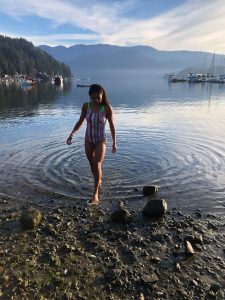
Blog Question: Write a short story (600 – 1000 words) that describes your sense ofhome; write about the values and the stories that you use to connect yourself to, and to identify your sense of home.
People still ask me where I’m from, as I serve them beer in 16oz cups, labeled “Deep Cove,” the neighborhood that my great grandparents on my mother’s side had “pioneered”. I grin and answer with a playful smirk, “I’ve been here since the 1940’s!” I acknowledge that my family history is problematic, being “pioneers” upon land that was already being actively used by the Tsleil-waututh people of the inlet. What I find equally troublesome is the shocked responses and facial expressions I receive because of my mixed-race “colonial” history.
My existence in the community I call my “home” sits at a contradicting intersection. Although I have ties to this land through my settler ancestry, I am perceived as a foreigner, rather than an anomaly, due to the pigmentation of my skin. Because I’m neither indigenous nor white, it is assumed that I must be from somewhere exotic. Although I have spent my entire life on these soils, making impressions in the forest with my feet, despite my active shaping of community, I am still “othered”.
I really only started to notice this as I got older, and I realized that I was one of the few “mixed-race” people in my years of public school. I started to feel as though people were intrigued by my existence because they thought they didn’t know it. The truth was, I was raised by my white, settler colonial family. I had experienced most of the samerealities as did they, the only difference was how “they” saw “me”.
This internalized social isolation I started to feel had led me to seek a sense of belonging. I started to reach outside of my community, seeking a network shared similar values to me, where I could feel a part of something. The first community I sought out was one that was brought together by a common love for the “land where I live”. Through reaching out to local activist communities, I started to make connections with people from the Tsleil-Waututh Nation, the people of the Inlet.
Through being introduced to the Tsleil-waututh Nation, I observed a community that has existed long before my “pioneer” family had arrived. This sense of belonging that was shared upon the land and between individuals spurred my curiosity. I appreciated the Nation’s resilience, interconnectedness, and shared values, and it inspired me to further seek a community for myself.
Although I never found a physical space or solidified community that shared the many intersections in life that I face, I did come to a realization. What I found was a deeper capacity inside me, to create space for myself and people like me. Community and spaces of belonging and acceptance are changing as we listen to the diverse stories of our neighbors and our friends. We are all divergent, but we also intersect in a number of ways. As musician and activist Tonye told me recently “we need to focus less on what makes us different, and instead, appreciate what we share in common”.
As of recent, I have been seeking out individual relationships in my small Deep Cove community. I have been making new friends based on shared interests is a way to create my own network of individuals, unbounded by race, gender, and socio-economic position. So far I’ve utilized the online realm to create a Femme-based cycling group based in Deep Cove, and I am working with a local cafe to start workshops on community sustainability. It is now our time, as individuals who face many “intersections” to re-appropriate space for each other, while acknowledging the contradictory history of the land, and the narratives that have pre-shaped how people perceive us.
Thank you for reading this week’s blog entry! I’m sure we intersect in one shape or form!
Keep taking space and “Flooding the feed”.
Lexi
Below I have attached a link to a short video I made in documentary film school called “The Land Where I Live”. I made this film at a time ofconfusion, regarding what my connection to the land was, as I am not indigenous, but I feel a deep attachment to it, and its wellbeing.
The second link I have included is an article about two community members and business owners in deep cove that are creating a community through sustainability.
Deep Cove to go plastic-straw free
Works cited
The Land Where I Live , 30 Oct. 2018, vimeo.com/157327712.
What a professional video—you are very talented! I have a bit of a connection to Deep Cove because my sister and her family live there so I visit them a lot. It’s such a beautiful place, amazing that you have deep family roots there. The Tsleil-Waututh are amazing at advocating for their land—whenever I hear news about Kinder Morgan, they are there. In the video, there’s talk about tourism being important to Deep Cove, yet my brother-in-law has said in the past few years it’s gotten out of control, especially the Quarry rock hikers (or is it the parking situation?) I wonder how we can reconcile our love of the land and wanting to share it with others but also wanting to protect it, too?
hey Andrea! Sorry for the late response, I didn’t see this message. I definitely agree with your brother, that the tourism has definitely made the local experience different. I do think there are grounds for creating a more responsible relationship between visitors, locals, and the land. I think it’s really important that the local businesses continue to create relationships with the local community while encouraging visitors to follow local protocols with the land. This won’t be easy, but it is important!